Meet the Marine Combat Veteran Making a Difference Through Tattoos
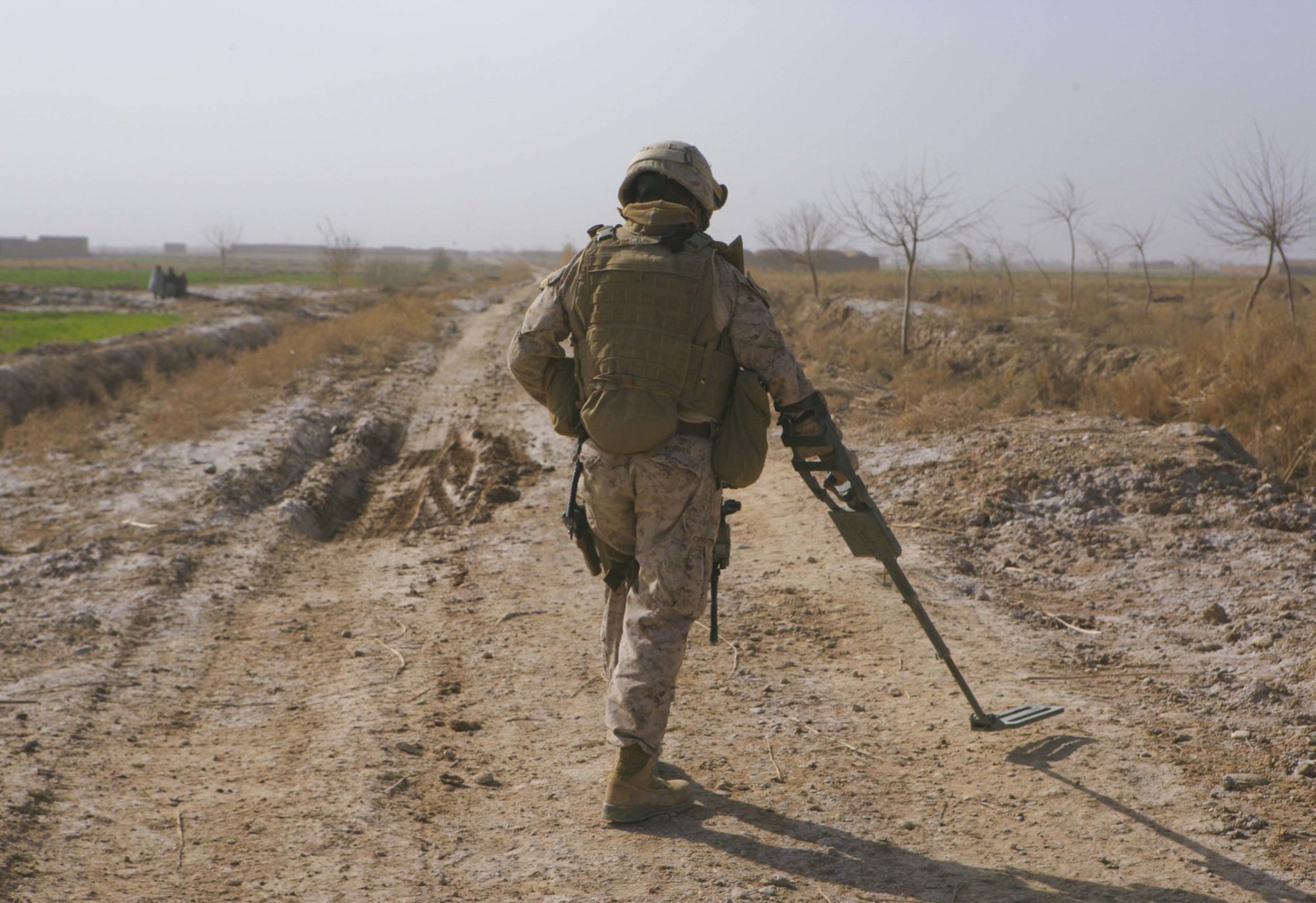
Sgt. Robert Torres, 1st section leader with General Support Security Platoon, Headquarters and Service Company, Combat Logistics Battalion 3, 1st Marine Logistics Group (Forward) sweeps the road for improvised explosive devices before travelling over it to attempt to recover an immobilized Mine Resistant Ambush Protected vehicle in Trek Nawa, Afghanistan, Feb. 25. The vehicle became stuck after a portion of the road it was travelling on gave out. The recovery was in support of 2nd Battalion, 8th Marine Regiment. Photo courtesy of the Department of Defense.
You know, we were supposed to numb you.” The thought had clearly just occurred to him.
I started to panic. “Has that not happened?”
He laughed. “That has not happened.”
Shit, I thought. It’s officially too late.
Andre Forrest, who works under the nom de plume Tatu Dreezy, wore a black baseball cap, backward, and a Philadelphia Eagles shirt with an American flag on the sleeve as he prepared to join ink with skin along my spine. Tattoos covered most of his visible skin, from his fingers to the nearly imperceptible ink that blended into his hairline and sideburns.
His shop, Penns and Needles on East 4th Street in Bethlehem, Pennsylvania, rang with deafening heavy metal music. Forrest’s business partner was on the other side of a low shelf, not speaking as he inked the torso of a wincing young woman. His needle quietly hummed.

Forrest’s artwork was tacked on almost every available inch of wall space — black-and-white animals, intricately designed calligraphy, a glorious full-color portrait of Rogue from the X-Men. A nonstop parade of teenagers looking to get pierced had kept the shop busy all day, but by the evening it had quieted down. Two of my friends, two of Forrest’s friends, and his wife all eagerly watched Forrest apply a purple stencil to my back.
I lay face down on the table as Forrest put on a pair of latex gloves. He is fastidious about hygiene, going through at least two dozen pairs of gloves during the two tattoos I had watched him ink over the previous six hours.
He showed me the needle he was going to use, and I confirmed that it was in a sealed packet. “Everything I use is disposable and vegan ink,” he explained. “The only thing I use that’s not organic is lidocaine as a numbing agent. Are you allergic to lidocaine?”
“Nope.”
“Benzocaine? Any type of -caine? Cocaine?”
“Do I get cocaine?” I joked, trying to stay calm.
“Free cocaine with every tattoo!” he replied.
He leaned in, and I heard the buzz of the machine turning on.
“Ready to party, dear?” he asked.
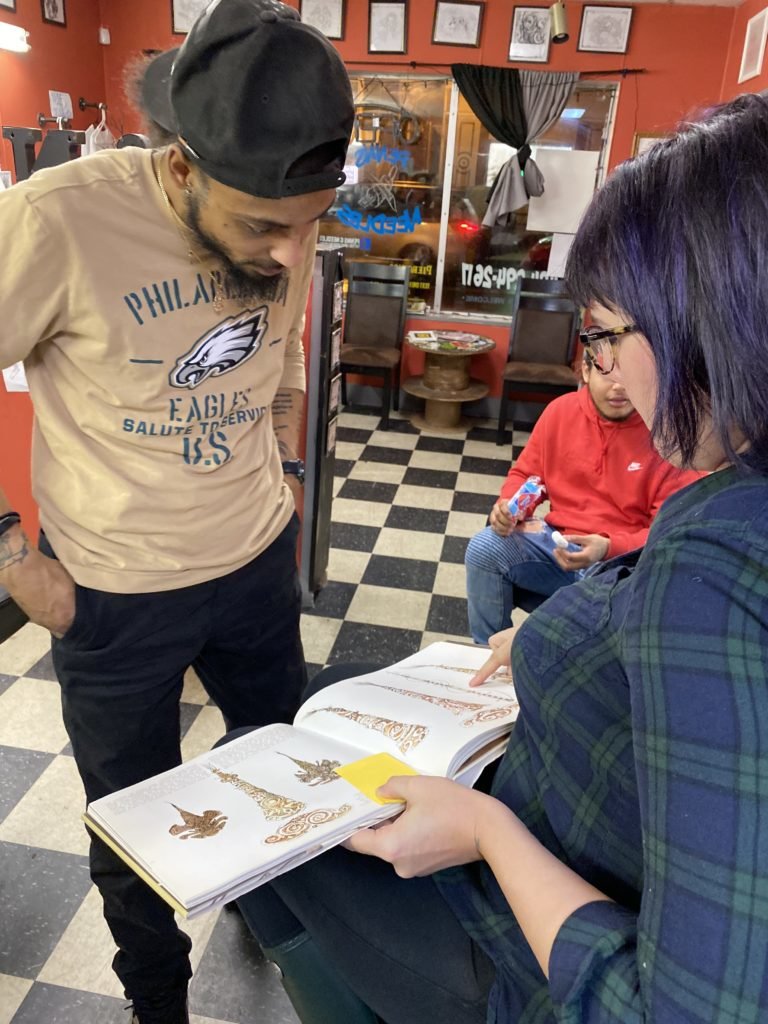
Forrest knew he wanted to join the US Marine Corps when he was young, about 3 or 4 years old. While he and his older brother were watching an episode of Beavis and Butthead late at night, a commercial for the Marines came on the TV.
“I see the freakin’ Marine climbing the mountain, slaying the dragon, and I’m like, ‘Man, I want to do that when I grow up!’” he recalled during his interview with Coffee or Die Magazine. “My brother looked at me like, ‘You’re a crazy little boy, man! Do you know what those guys do?’ And I’m like, ‘No, but he’s killing a dragon — that’s COOL! What the fuck, I wanna kill a dragon!’ And that image just stuck with me.”
Forrest was a “knucklehead juvenile” who bounced around between family members’ homes in New Jersey. His first attempt to join up, at age 17, was unsuccessful due to his legal record. But when he tried again the following year, he lucked out. “It was the surge at the time so they were trying to get people in,” he said, referring to the George W. Bush administration’s 2007 decision to deploy more than 20,000 additional US forces into Iraq and extend the tours of service members already deployed in country in the face of a rising insurgency. After he went to summer school and received his high school diploma, he headed to boot camp in September 2008.
He scored well on his ASVAB and told his recruiter that he was hoping to work on utilities, since he had been doing heating vent and air conditioning work as a civilian. “So they left it open option — little did I know combat engineer fell under that option,” Forrest said. “So by the time I go to get to my schoolhouse, and I find out what I’m doing, they’re like, ‘You ever hear about those guys who look for land mines? Yeah, you’re gonna be THAT guy.’” He was shocked. “I was like nonononononono, this is not for me. No.”

But he soon learned that his new career path played to his greatest strengths — his concentration and imagination. His training involved being put in scenarios where they would “figure out the puzzle piece stuff,” he said.
“Where would I stick an IED at, where would I be, what will cause the most damage?” Forrest looked around the room. “Everyone’s coming into the shop right now — the best place to stick it would be at the front door.”
In the eyes of a combat engineer, an improvised explosive device could be hidden anywhere, in the most banal possible places. Even litter wasn’t safe from Forrest’s perspective. “‘Oh, what’s a box of Newports doing on the ground? Obviously some troop dropped it!’ Don’t touch it. Leave it alone. Let us check it out before you grab it off the ground because more than likely it wasn’t meant to be picked back up — and if it was, it was meant to cause damage.”
“We pretty much got into it like a criminal investigator would get in the mind of a serial killer,” explained his friend Greg Miller, who served with Forrest on a deployment to Afghanistan in 2010. The job of a combat engineer working in route clearance required the creativity to get inside the brain of the Taliban.
It was Forrest’s second deployment when he and Miller were clearing IEDs in Sangin with the 2nd Combat Engineer Battalion, in Route Clearance Platoon 1 Mobility Assault Company. “We had a lot of missions where we had a lot of close calls. We actually got blown up in a truck together. The truck we got blown up in, we had that truck for probably about…” Miller paused, then turned across the shop, looking over to where Forrest was tattooing. “Yo, how long did we have the truck before we got the AC fixed?”
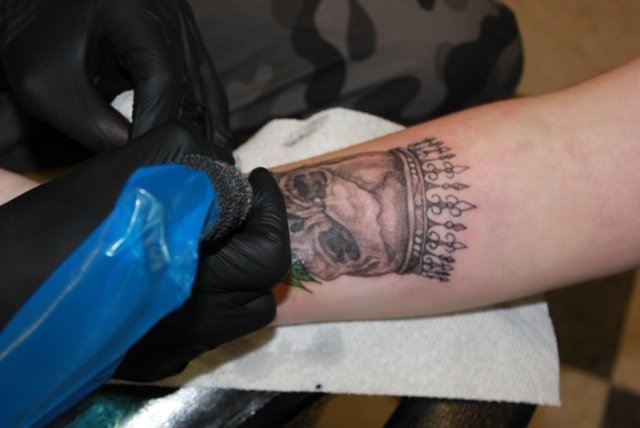
“HA! That was a good joke!” Forrest said. “I think about three months before that air conditioner got fixed, and then right after the air conditioner gets fixed, two days later, boom, get blown up. It took us three months to get that truck to 100%.”
“So for three months we’re rolling around Afghanistan with no AC — it was between 90 and 105 degrees like every day we were there,” said Miller.
“I saw the truck thermometer would say like 130. Dying. DYING,” Forrest emphasized.
“We’re in there in full flak and Kevlar, full combat load, and we have no AC. So we were like in an oven,” Miller continued.
In their newly air-conditioned truck, Route Clearance Platoon 1 Mobility Assault Company was sent down a route that no one had used for two months. They were driving down the street toward a curve, which Miller and Forrest thought was a perfect spot for insurgents to have placed an IED. In the time since any eyes had been on that road, the IED could be completely weathered over.
Miller, as the gunner, saw a compound where a crowd of kids were playing. He carried a supply of candy with him. “My plot, and Forrest agreed with it, was if I take candy out and I wave it at the kids, and they don’t come running out, something’s wrong. So I waved the candy around and the kid looked at me and started running, and his parent called him back.”
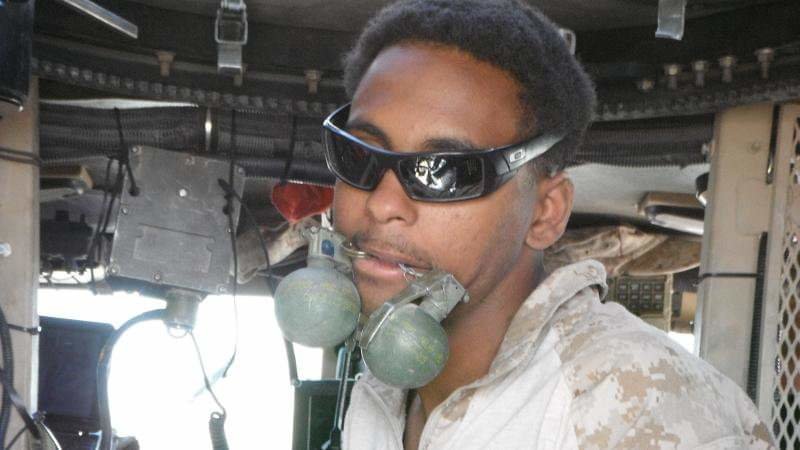
“Oh, that boy listened,” said Forrest, nodding.
“I was like, this is gonna be a bad day,” continued Miller.
The sonar detector showed nothing, but as soon as they hit the curve, a 50-pound IED exploded. Miller went flying upward, caught by the makeshift sniper shade they had assembled out of HESCO and camouflage netting for their truck. Forrest suffered a back injury and, along with their dog handler, ended up on limited duty.
“You can’t really be panicked when it comes to something like that,” Miller said, explaining how Forrest responded to the incident. “He has fundamentals that he applies to everything. And you could see that, especially when it came to the way he was training everybody. He always had a method, but he wasn’t opposed to trying new things and learning new things — just going out there, going out beyond what he’s normally accustomed to.”
As fun and full of positive energy as Forrest was, he was also incredibly serious about his leadership role. According to Miller, Forrest was invited to many mission briefings. “What he knew about all the stuff that happened before could apply to what they were trying to do now.”
“I know we haven’t slept for 160 hours, 190 hours, whatever the case may be. I know that,” Forrest said. “But guess what? You’ve gotta be just as good as you was leaving as you are coming back in. I get that you’re tired, but complacency kills. You’re getting complacent because you’re tired. You need to wake up. At your worst you’ve gotta still be at your best. It’s not Call of Duty. There’s no respawns after this point.”
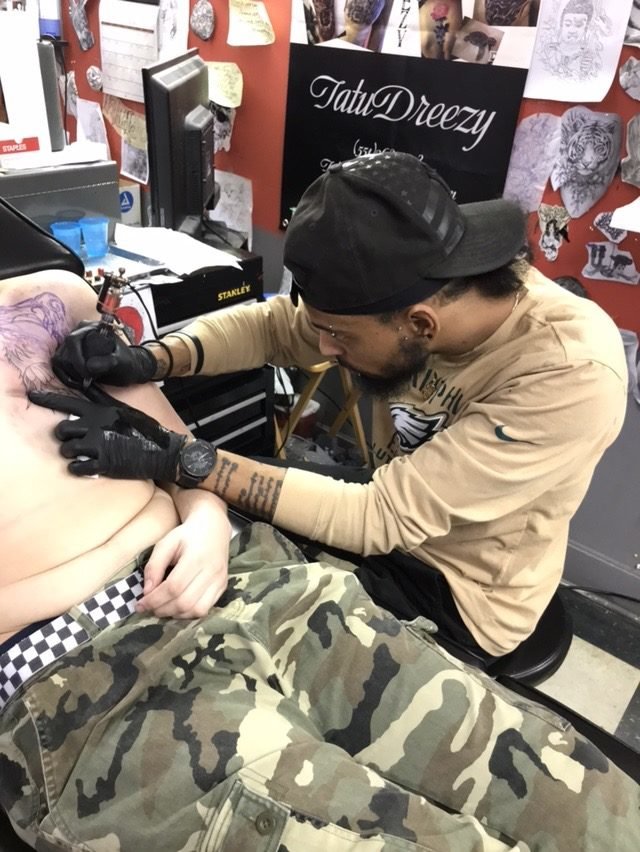
Forrest went into the Marine Corps with one tattoo, but left with many — discovering a passion for the art along the way. He inked his first tattoo on June 30, 2013, shortly after leaving active duty, but his path toward becoming a career tattoo artist wasn’t so straightforward.
He initially considered going active reserve but decided it wasn’t for him. “The mindset was completely different,” Forrest said. “I liked it at first, but there were guys who were just reserve-reserve all the time, and I was like, ‘I can’t — there’s no way to mingle with these guys.’ I’m looking at this gunnery sergeant over here, and I’m like, ‘Sheesh, I’m like three rows deep, bro. You’ve only got two ribbons — what’s going on? You been deployment dodging for the last 14 years?’”
The same went for the idea of applying his IED detection skills to a smaller police force. “I couldn’t go to the civilian side and start working bomb squad for New York. I can’t have a guy who’s worked for a bomb squad for 30 years and never seen a bomb a day in his life tell me how to do my job. It’s not going to happen.”
Forrest also thought about going into psychology so he could “work with guys coming back from combat, being a combat guy myself.” But ultimately, that line of work just wasn’t a good fit. “Who wants to sit in a chair for X amount of time and listen to somebody beating their head? What’s the next best thing I can do?”
“At your worst you’ve gotta still be at your best. It’s not Call of Duty. There’s no respawns after this point.”
At that point, tattoo art seemed to be the only thing he could actually see himself doing for the long term. “It helps out a lot of people. You’re somebody’s psychologist for the next god knows however long they’re sitting in your chair — three, four hours,” he said. “Someone’s telling you their life story, and more than likely you’re conversing with them about your life story.”
Forrest took a chance and bought the necessary machines. He started getting back into art, which had been his passion for many years. “He was always drawing,” Miller recalled. “We had a table that was back at our FOB that we worked at in Afghanistan, and the table had a bunch of graffiti on it from different people, but he drew most of it on there.”
“It’s a big misconception in the tattoo community — a lot of people now, because it’s getting a little easier to learn how to tattoo [on] YouTube, stuff like that, so a lot of people think they know what they’re doing right away — but there’s a difference between art and tattooing,” said Forrest. He pointed at the customer in front of him. “I’ve wiped away half of the stencil that was on him, but I’m an artist, so I know where stuff goes — I know where to put it back at. A lot of these guys wipe away a stencil and since they only know how to tattoo and don’t know nothing about art, they’re all panic mode.
“You’ve gotta have love for this stuff,” Forrest continued, “because guess what? The money’s not going to come all the time. And guess what you’ve still gotta do? Draw, paint, airbrush, whatever your medium is, you’ve still gotta do it anyway.”
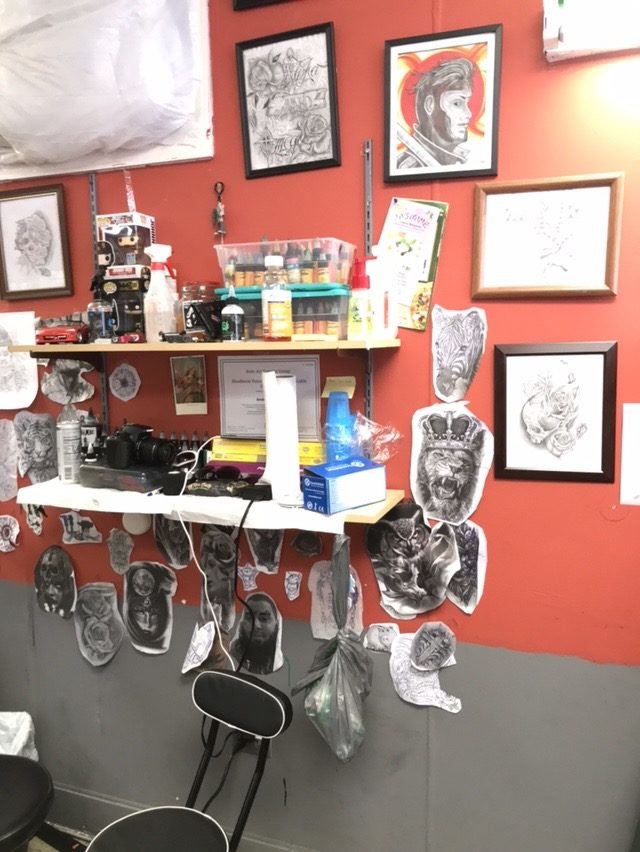
It was through that combination of passion for visual art and commitment to the psychological benefits of tattooing that he reconnected with Justin Eggen, a fellow Marine Corps veteran who turned to poetry for his artistic release. “I’ve put that stuff into words in such a way that emotionally it drained me to write it. So once it drained me, it was gone,” Eggen said. “And I feel like Forrest may have the same thing when he tattoos people. I think he gets the same exact release when he gets to share his art, and he gets to let it go.”
A few years ago, they attended a funeral in West Virginia for a buddy who had committed suicide. “We were pretty close to the guy, and everybody was really surprised,” said Forrest. “Like, Wow, not this guy — out of all people. It was definitely a shocker. So a lot of these guys were hurting, and I was like, I know the best way through pain — through a tattoo.”
Forrest stayed up all night tattooing his friends, from 5 in the evening until 10 o’clock the next morning. “I tattooed them in painful spots, too, like kneecaps, close to underneath armpits. It beats emotional pain. Better than drinking and drugs. Way better than what a lot of other guys turn to.”
Eggen valued the time he spent with Forrest. “I know a lot of people, and I still haven’t met anybody to this day that has that sort of energy, that puts that out,” he said. “I don’t know how he does that, I don’t know where he gets it, that drive to be like that.” When Eggen set out on “Verses and Curses,” a spoken-word tour that made stops along the entire Eastern Seaboard with fellow veteran poets David Rose and Leo Jenkins, it occurred to him to invite Forrest along.
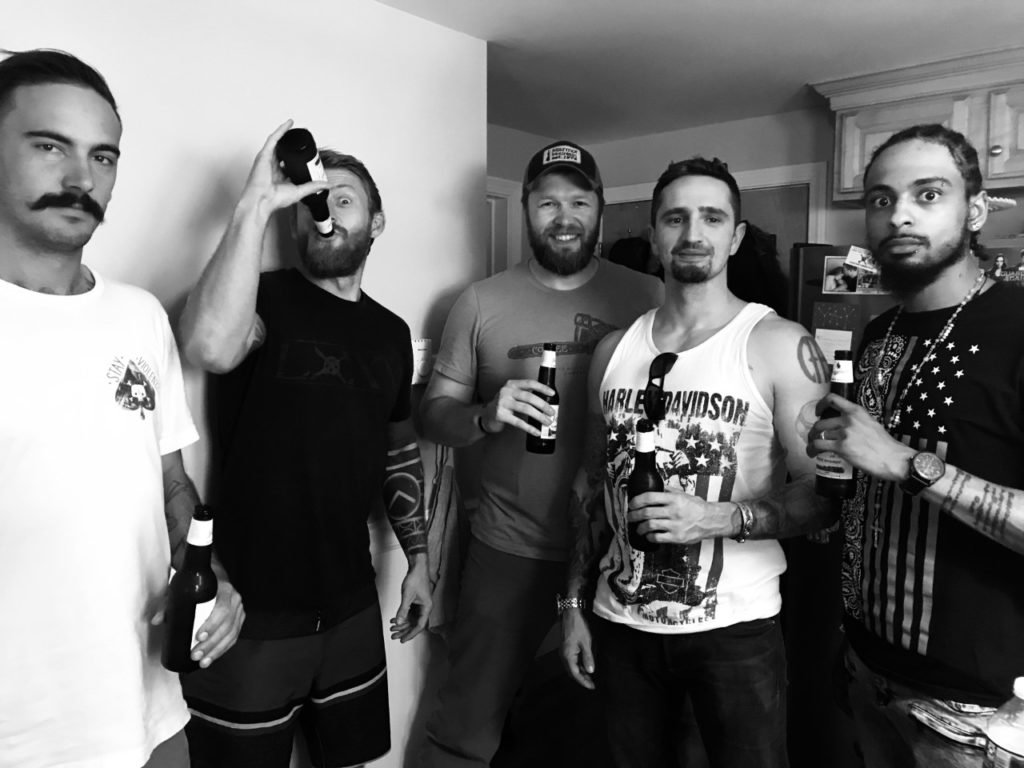
“I don’t know these guys, and they’re going to be hanging out with each other, they already know each other,” said Eggen. “So I called up Forrest and was like, ‘Hey, do you want to ride in an RV with me and fuckin’ hang out with me for like four or five days? I’ll get tatted by you and everything, dude — just come hang out with me.’”
The poets met Forrest in New York, and he quickly became integral to the tour. “I think what we realized midway through is that Andre should have been part of it,” Eggen said. “He should have been part of the marquee, the names on the poster. Because he put in an equal amount of work and an equal amount of generating people to give a shit about it.”
“I was everything for them,” explained Forrest about his jack-of-all-trades role on the tour. “I was their hype man.”
Before their first show in New York City, he enthusiastically handed out flyers and rounded up people to come inside. “If you know him, you know he doesn’t give a shit about talking to anybody,” Eggen said with a laugh. “He’ll walk up to anybody and be like, ‘Hey, you’re gonna come in here and watch this because my buddy’s doing poetry.”
“A lot of guys don’t want to do nothing when they get out because they don’t feel it’s big anymore. But if you can’t work a 9-to-5, you could do the self-made route …”
“Their generator broke on them, I fixed the generator,” Forrest recalled. “Stage lights weren’t working, I fixed the stage lights. Having microphone issues — we were having so much technical problems, everybody’s losing their minds, and I’m like, ‘Just get out of the way and let me deal with it. I got this.’”
Forrest’s positive energy was undeniable. “Leo Jenkins read this really strong poem to end the night at the New York event, and he put the mic down, and it was like, done,” Eggen said. “And then Forrest walks up and grabs the mic and starts giving his goodbyes. He just walked up there and was like, ‘I don’t care that this just ended — I’m going to continue it anyway.’”
The tour was documented by fellow veteran-turned-filmmaker AJ Miller for a short film titled More Than Our War, and Forrest was shocked by how much he turned up in the background. But according to Eggen, Miller regretted not featuring him more. “He was like, ‘Man, I fucked up — I should have gotten more of Forrest in the fucking movie,’” said Eggen.
Forrest was prominently featured in a scene giving Eggen a tattoo. While the RV was filled with what he called “headbangin’ music — Korn, Metallica, fuckin Slipknot,” the camera caught a shot of Forrest’s tattoo ink descending languidly through a plastic cup of water.
In the shop, Forrest sang quietly under his breath to Tool’s “Sober” while carefully inking a raven onto his customer’s chest. “You wanna know if it hurts, just watch my face,” the customer said.
“He started saying ‘Jesus’ earlier, and I was like, ‘Speak to me, child,’” Forest joked. “I can’t answer that many prayers in one day, calm down.”
As the needle inched closer to the customer’s left nipple, he sucked in his breath. My anticipation level for my own tattoo rose, and it was apparent to everyone around me. Miller turned to me and offered me a drink from a bottle of Crown Royal sitting in a paper bag on a table.
“Oh, don’t worry — I came prepared,” I responded, pulling out a silver flask three-quarters full of Jim Beam and taking a generous swig.
“You ever had a rug burn?” Forrest’s friend Egy asked me. I nodded. “It’s like that.”
“Okay, so just the most painful rug burn on the planet,” I replied.
“Yeah, just a thousand times per minute, hitting you, dragging along,” he said. I laughed.
“It’s a smaller needle in here,” Forrest said, explaining the wince on his customer’s face. “The smaller the needle, the more it stings, the more of that paper cut feeling. The bigger the needle, the more of a punching feeling.”
The focus and precision needed to use that smaller needle was something he developed in the Marines. “Everything I learned in the military, attention to detail, 45-degree angles, alignment and punctuation and stuff — a lot of that I transferred over into tattooing,” said Forrest.
On top of affecting his art, his military skills also affected his ability to work through the chaos of the busy shop. “You’ve got to learn to block out everything that’s going on and focus on the task at hand,” he said. “I mean, looking for IEDs, you’re getting shot at, but you’ve got to ignore those bullets.”

“They never shot machine guns, it was always RPGs,” Miller contested.
“One time they tried,” Forrest argued. “Lo and behold, Lance Cooley Forrest was in the .50 cal.”
Miller immediately remembered the incident. “There’s no form of life. It’s completely desolate,” he said. “And sitting in the middle of the street is this rice bag. It’s just sitting in the middle of the street. And I’m like, ‘This doesn’t feel like a setup at all.’”
Their trucks began to carefully sweep the bag of rice for IEDs, but a white vehicle squeezed past their convoy while they were distracted. Two men jumped out and ran into a nearby compound.
“We’re just looking back and forth at each other like, ‘When’s it gonna happen?’” said Forrest. “We know this is a setup, where’s it gonna happen at?”
As the convoy pushed forward, the two IED-detecting trucks in the front began taking AK-47 fire from inside the compound. On the narrow roads in Sangin, there was no way for them to turn around. So Forrest swung the .50-caliber machine gun over the truck in front of them and fired at the insurgents inside the compound.

His aim was impeccable, and he hit one of the men immediately. “His body exploded right in half,” said Forrest. “It was pretty gnarly. I hit him center mass and literally — right in half.” The other insurgent ran off into a poppy field behind the compound as Forrest grabbed his M4 and began shooting. “He cut hard right into the tree line, and I’m pretty sure I shot him in the ass.”
On both of Forrest’s deployments, to Marjah and to Sangin, the insurgency heated up when poppy season began. “It was very kinetic,” Forrest described. “It’s everyday all day. It has to do with the money. They want to traffic it out of there. Call it for what it’s worth, these guys are trying to get their poppy out of that country, so they’re trying to defend what’s theirs, what’s their property.”
“We’ve had a two-hour firefight, we’ve had close calls when we were with Special Forces,” Miller recounted. “We had an RPG literally fly over the hood of our truck. He was in the gun, and I was sitting down in the back of the truck, and I literally watched the smoke from the thing just barely clear the hood of the truck as it flew over.”
“Hopefully the guys to the left and right of you know how to do their jobs pretty fucking good, that’s basically what it comes down to,” Forrest said. “There’s got to be another word for trust — there has to be a better word than that. Because if the person to the right or left of you is not passionate about going the fuck home, then you’re not going home either. You’re going home in a body bag or a box. For real.”
“I know I’ve got no choice but to shoot for perfection, like the military taught us — always try to be better.”
Forrest moved on from his raven tattoo to a small tattoo on a new customer’s face. He didn’t lose focus for a second. “I’ll be tattooing all day — 10 hours, 12 hours — and I’m fine the entire time,” he said, concentrating intently. “But as soon as I’m done-done, my head will start spinning, I get ill — finally you’re coming down. It’s just like the high of being in combat. I would definitely say I’m an adrenaline and endorphin junkie. I don’t drink really, I don’t do drugs, so this is almost a high to me. I know I’ve got no choice but to shoot for perfection, like the military taught us — always try to be better.”
The customer getting the face tattoo looked at his phone the entire time, not flinching for a second, but Forrest explained more about his approach toward chatting with customers who are in a bad place mentally. “I end up telling them about my military times when I was deployed — fucking sleeping in sand, getting sand in my eyes first thing in the morning when you wake up, or I didn’t shower for two, three weeks at a time. I’m not trying to sit there and tell you don’t feel bad because you’re going through a bad thing, but a lot of people go through bad stuff and they find their way out.”
He stays in contact with Marine buddies, many of whom are still on active duty, and they still look to him for guidance and leadership. “It’s a good feeling, that a lot of these guys still call to ask me for which way to go about things — I feel like I made an impact.”
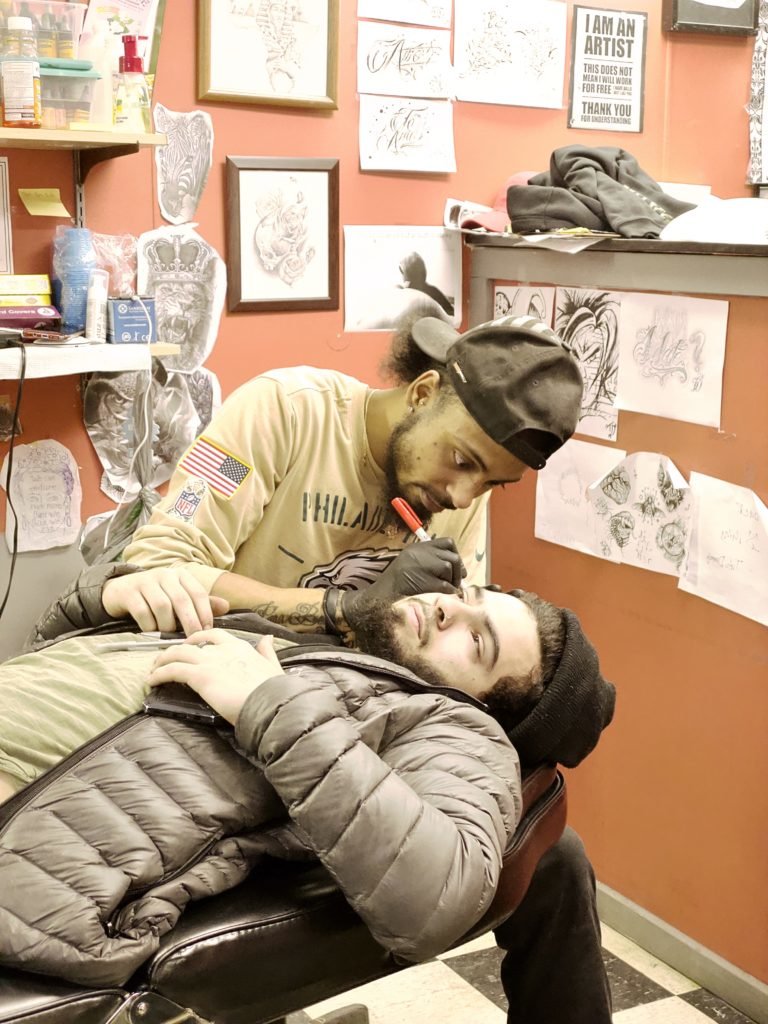
Forrest gestured toward Miller. “I never really looked at it until I started having guys like him or Justin, guys who are like, ‘Man, you’ve really made a difference to a lot of these guys, you took care of guys post service,’ and I’m like, ‘Isn’t that what we’re supposed to do, is take care of each other?’”
“I think that’s why everybody did have a lot of affection and cared about him, still talk to him, and still want to be around him,” Eggen said. “He’s still a relevant person in a lot of people’s lives even after the military.”
Since 2013, Forrest and his wife have housed a number of veterans who were homeless or suicidal. “I understand what they’re going through,” he said. “I had something to let myself go into, which is my art. A lot of guys don’t. And because of that, I was willing to help them out at their worst time, so they could know someone’s there and not just let them go, let them be, let them rot, how they feel like the system has done to them.
“I’m telling guys, you can still do what you love and use what the military taught you and apply it to whatever you love and still chase your dreams,” Forrest said. “A lot of guys don’t want to do nothing when they get out because they don’t feel it’s big anymore. But if you can’t work a 9-to-5, you could do the self-made route, and there’s a real strong possibility you could do it. Be able to take your time and reintegrate yourself because you’re working with people one-on-one instead of in a mass. It helps — it really does.”
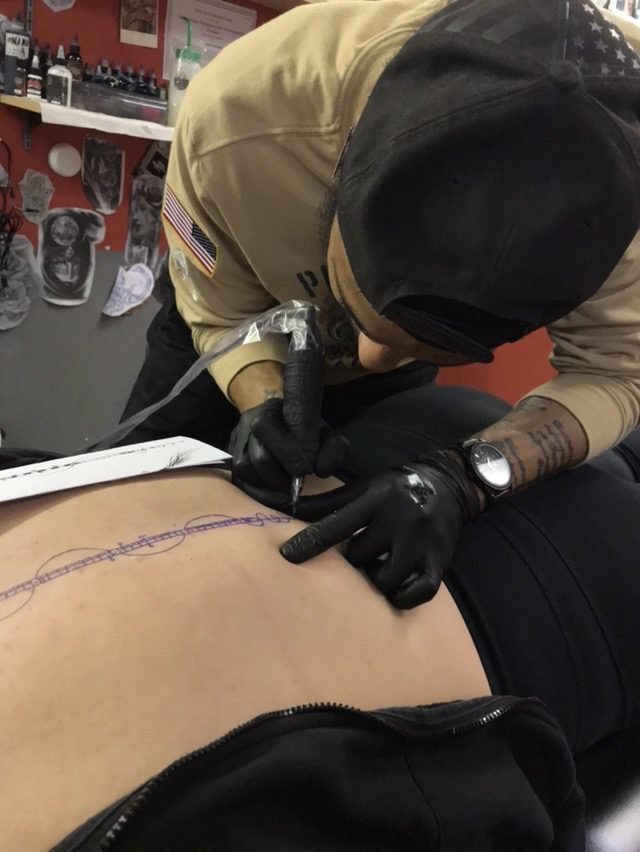
The small crowd of people in the shop watched my reaction intently as Forrest applied his “silent but deadly” needle to my spine.
“I don’t hear no crying,” Forrest’s wife said with a laugh.
“I’m not crying!” I said, surprised.
“I’m proud of you,” she replied.
After hours of psyching myself out about getting my first tattoo in 16 years, I was pleasantly surprised by how unruffled I was by the pain. And the spectators were rooting for me. The atmosphere in Forrest’s shop was one of unrelenting positivity, except for the stereo blaring “Let the Bodies Hit the Floor.” “It’s the national military song,” Forrest joked.
Before I knew it, he was finished. “What do you think guys, should I take it off and do it again?” Forrest asked jovially. “Where’s my cheese grater?”
“I didn’t shed a single tear — I’m disappointed!” I said as he snapped on a new pair of gloves to wipe my back down.
“That’s it, we’re done-done,” he declared, and everyone in the shop cheered.
That was simply the energy Forrest brought to the room. “He’s just that driving force, he’s very positive, he’s very in-your-face kind of,” Eggen said. “He’s one of the most genuine dudes I’ve ever met in my entire life.”
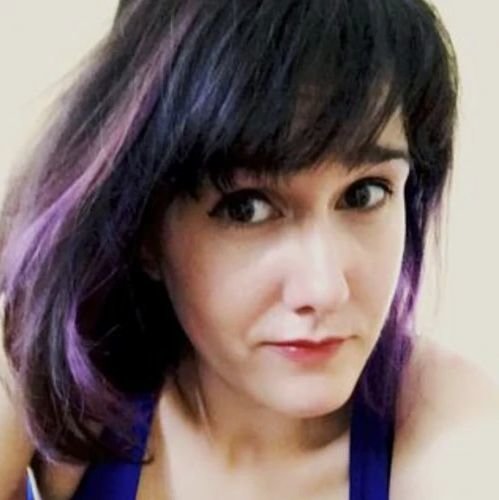
Maggie BenZvi is a contributing editor for Coffee or Die. She holds a bachelor’s degree in political science from the University of Chicago and a master’s degree in human rights from Columbia University, and has worked for the ACLU as well as the International Rescue Committee. She has also completed a summer journalism program at Northwestern University’s Medill School of Journalism. In addition to her work at Coffee or Die, she’s a stay-at-home mom and, notably, does not drink coffee. Got a tip? Get in touch!
BRCC and Bad Moon Print Press team up for an exclusive, limited-edition T-shirt design!
BRCC partners with Team Room Design for an exclusive T-shirt release!
Thirty Seconds Out has partnered with BRCC for an exclusive shirt design invoking the God of Winter.
Lucas O'Hara of Grizzly Forge has teamed up with BRCC for a badass, exclusive Shirt Club T-shirt design featuring his most popular knife and tiomahawk.
Coffee or Die sits down with one of the graphic designers behind Black Rifle Coffee's signature look and vibe.
Biden will award the Medal of Honor to a Vietnam War Army helicopter pilot who risked his life to save a reconnaissance team from almost certain death.
Ever wonder how much Jack Mandaville would f*ck sh*t up if he went back in time? The American Revolution didn't even see him coming.
A nearly 200-year-old West Point time capsule that at first appeared to yield little more than dust contains hidden treasure, the US Military Academy said.












